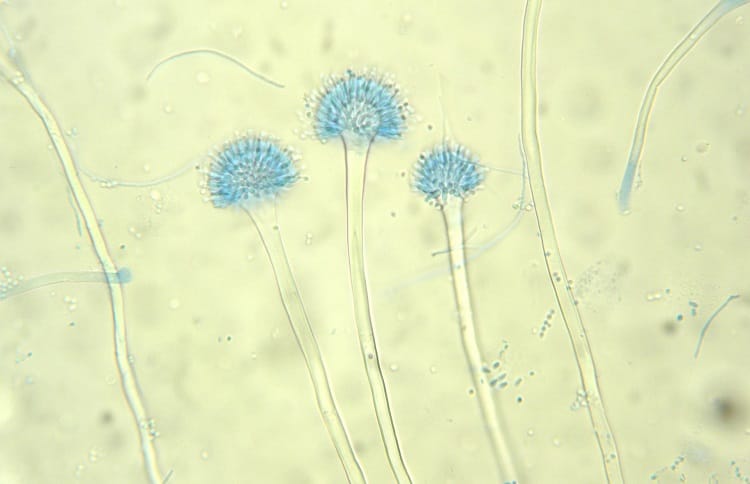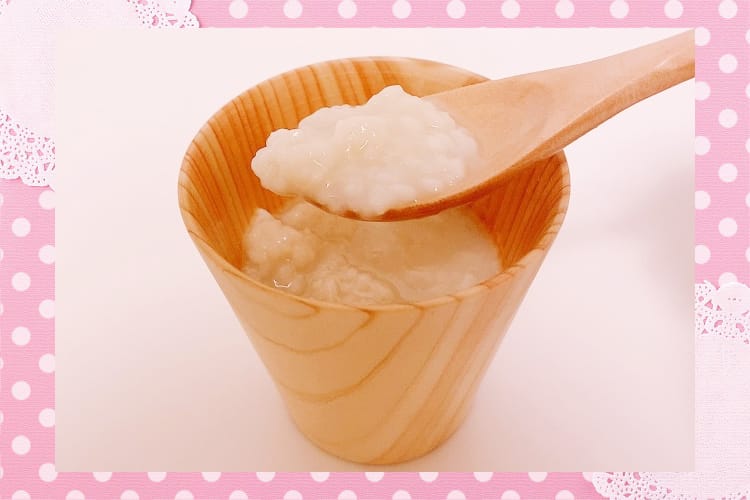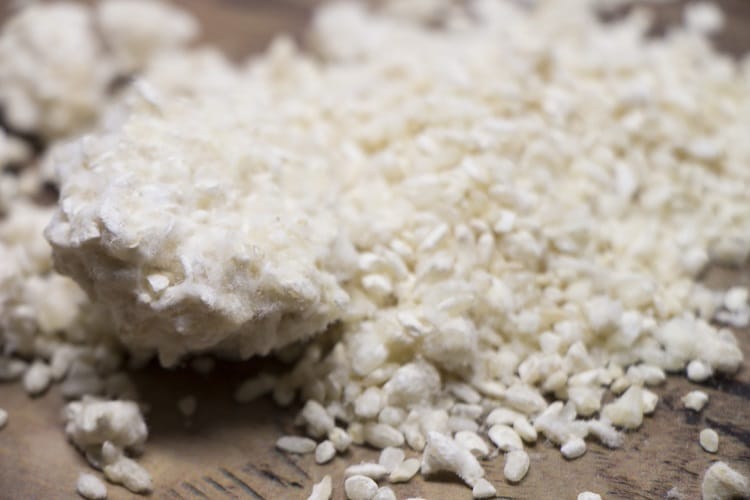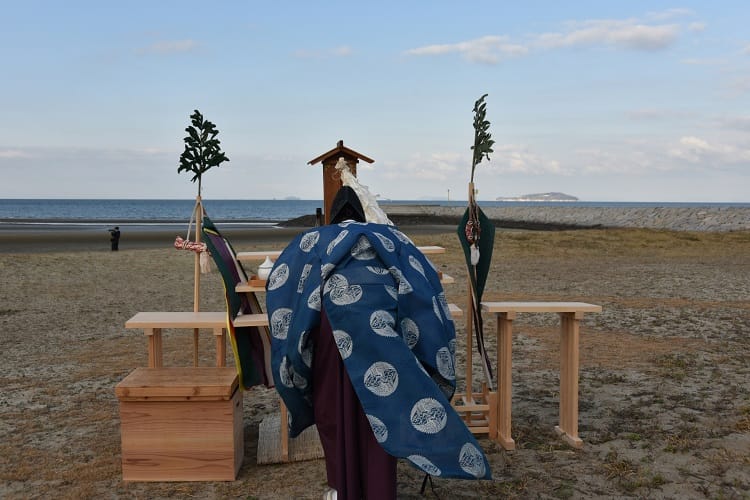
Aspergillus is an indispensable part of Japanese food culture. In brewing, it has been designated as a "national bacterium", and many studies have been advanced, and its nutrition and health effects have become widely known. Rice koji is obtained by cultivating Aspergillus niger on steamed rice, and the koji amazake made only from rice koji and water (or rice) is effective only for a long time without knowledge of nutrition and science. By experiencing this, it was close to being useful for physical condition management. It is said in Oriental medicine that it works to improve water metabolism in the body.
Perhaps the reason why it has not been abolished through the times is because of its deliciousness with natural sweetness. The nourishment that soaks into your body and the nostalgic and relaxing scent can be enjoyed as it is, or with a combination of vegetables and fruits. In addition, it adds sweetness and richness to the dishes, and finishes the sweets with a mild sweetness.
What is koji mold?
Japanese food, which is considered healthy and good for beauty, has gained popularity in Europe and America.2012In XNUMX, it was registered as a UNESCO Intangible Cultural Heritage as "Japanese food: Japanese traditional food culture". Today, sushi and miso soup have spread throughout the world, and tofu has also attracted attention as a valuable protein source for vegans, and is now one of the world's favorite ingredients that can be easily obtained at supermarkets and other places around the world.
One of the characteristics of Japanese food is that there are many fermented foods. In addition to pickles and natto, most of the familiar seasonings such as soy sauce, miso, mirin, sake and rice vinegar are made by fermentation. The essential ingredient to make these seasonings is koji.
Koji is made from steamed cereals and legumes that have a mold called "Koji mold". Aspergillus (Aspergillus) releases various enzymes to proliferate, and breaks down starch and protein contained in foods. As a result, the umami ingredients such as amino acids are produced, which makes them feel delicious.
There are many types of Aspergillus, which are very common in nature, but the type called Aspergillus oryzae is mainly used in Japan. This is also called "Japanese Aspergillus" and is used in the production of sake, mirin, miso, and soy sauce. Japanese Aspergillus,2006In XNUMX, it was certified by the Japan Brewing Society as Japan's unique "country fungus". In addition, there are "Tamari-koji mold" used for the production of tamari soy sauce and "Awamori-koji mold" used for awamori and shochu in Okinawa. Katsuobushi, which is also used in broth that is indispensable for Japanese cuisine, is one of the fermented foods made by koji mold "Katsuobushikabi". In this way, Japan's food culture is a representative of the country that supports our dietary habits, even without koji mold.
The rice koji used for koji amazake is “rice koji” made from white rice. Freshly made rice koji is fluffy and looks like a flower, so it is written in rice as a flower, and the word "koji" is given a poetic notation that makes you feel the beauty of Japanese again. There is also. What is commercialized as it is is called “raw koji”, and the one dried after removing moisture is called “dried koji”. When dried, the activity of Aspergillus stops, so there is no risk of decay and it is suitable for long-term storage. There are two types, "rose koji" and "plate koji", but the contents are the same except for the shape. In addition, there is no difference between raw koji and dried koji, so it is better to select one according to the usage.
Generally, rice koji is made from white rice, has no habit, and has a strong sweetness. It is the source of sake, rice miso, mirin, vinegar, and amazake. Brown rice koji is characterized by its low sweetness and unique richness and aroma. Making amazake with brown rice koji does not have the strong sweetness of white rice koji, but you can enjoy the deep richness and strong aroma of brown rice.
Barley malt is made from barley and naked mulberry and has a rich flavor. Used for making barley miso and shochu. Bean koji is made from soybeans, chickpeas, and red beans, and is used as a raw material for soybean miso. Miso miso is rich in peptides that bring out the richness and depth of complex flavors, making it ideal for stewed udon, miso oden, and other stewed dishes. The feature is that the more you boil it, the more the body comes out and the more delicious it becomes. Soy protein also has the effect of eliminating the smell of meat and fish, so it is also recommended for mackerel miso. When heated, it smells savory and also increases appetite. In addition, Soritsu koji from Amami Oshima is made from the seeds of Sorut and used for traditional miso making.
In this way, the taste of koji is changed depending on the ingredients, creating a rich local culture and a diverse food culture.
Why koji is loved by Japanese
Fermented foods using koji molds began in ancient China. The technology was introduced to Japan in the Yayoi period and the Kofun period. The oldest document that has a record of koji8This is a description of sake brewing in the Harima Country Fudoki, which was established in the early Nara period of the century. "Okamihi's groceries die and grow moldy, that is, sake is brewed and dedicated to garden sake (festival festival) and feasting (dry rice is wet and mold grows, and this is how we made sake)" Therefore, the discovery of Aspergillus is thought to be due to chance. Moldy rice is called "Kamudachi" or "Kamudachi", and "Koji" is also said to be an accented word.
The yellowish green color of the koji spores was considered to be a noble color, and was used for the emperor's costume called "Kikujin no Ho". In the Muromachi period, powdered spores of koji mold were collected and commercialized.
In the Edo period, sweet sake made by adding koji to cold porridge is becoming popular among the common people. Because it can be easily cooked overnight, it is also called "overnight liquor", and is filled with a pedestrian bar stick (bote-furi) carrying a balancing rod.6~8Sentence (about150~200Yen). There was also a teahouse where you could drink amazake. There are famous shops such as Mikawaya, Iseya, and Osakaya in front of Higashi Honganji Monster in Asakusa, and Mikawaya and Amanoya in front of Kanda Myojinmon are still open today.
Amazake now has a strong image of winter drinks, but in the Edo period, amazake was sold well in summer. At the time when medical treatment was not as advanced as today, summer batter often caused death. Amazake made with koji, which contains various nutrients that are good for health, was used as an energy drink today. As described above, koji has long existed as one of the elements that form the perspective of Japanese things, the way of thinking and the spirituality, in close association with the Japanese culture.
Health effects of rice koji amazake
In recent years, the health benefits of Amazake have been renewed attention, and various products have been developed. Academic research, such as genome analysis of Aspergillus, is also underway. As a result, various effects of koji amazake, such as recovery from fatigue, diet, disease prevention and intestinal action, have been scientifically supported, and it has become a hot topic overseas as "Japanese yogurt."
Let's take a closer look at the health benefits of rice koji amazake, which is currently attracting attention.
https://www.instagram.com/p/BvaJbnbFDfE/?utm_source=ig_web_copy_link
Summer batter and fatigue recovery
Summer batter symptoms such as indigestion, loss of appetite, and sluggishness are caused by the high temperature and high humidity environment and sudden temperature changes caused by air conditioners, which cause stress that causes the autonomic nerves to malfunction.
The best way to restore the autonomic nervous system is to relax, but koji amazake is an amino acid that acts on the autonomic nervous system and works to relieve tension.GABAis included. The relaxing aroma and mild sweetness of the koji soothes and relaxes you. As the koji mold helps digestion and absorption of the nutrients taken at the same time, it easily supports the gastrointestinal tract that has weakened due to summer batter.
Glucose contained in koji amazake is a monosaccharide, the smallest unit of carbohydrates.1It is also called glucose. The molecules are so small that they are quickly absorbed into the body and converted to energy. When you are tired, you want sweets because your body demands energy. Athletes can expect a quick recovery of energy by drinking a little koji amazake in the same way that they consume glucose or bananas that are quickly converted to energy instead of meals before the competition.
Vitamins for koji amazakeBThere are many groups. Vitamins called "vitamins for recovery from fatigue"B1Vitamins to keep muscles, skin, hair, nails, etc. healthyB2Vitamins required for skin and mucous membrane regeneration and immune functionB6,500There is niacin which helps various kinds of enzymes. vitaminBThe main function of the group is to metabolize carbohydrates, lipids and proteins into energy. It is more effective to take many types together than to take them alone as a supplement. Therefore, by drinking koji amazake containing many nutrients, vitamins can be effectively consumed.BIt can be said that the group can be consumed.
In addition, rice koji, which is a raw material for koji amazake, contains particularly high molybdenum, which promotes the function of iron, making it a strong ally for women suffering from anemia. It also contains a lot of folate, which is essential for the formation of red blood cells and important development, so it is a safe and secure natural supplement that is ideal for pregnant women.
The effect of preparing the intestinal environment
It's no exaggeration to say that our health depends on our intestines. The gut's role is not just absorbing nutrients and excreting waste. The gut is home to XNUMX-XNUMX% of the cells responsible for the body's immune function. Good intestinal conditions increase immune function and can prevent and improve various diseases.
Japanese colon is on average more than Westerners2~3It is said that Japanese people are more prone to constipation than Westerners. By the way, the intestines of herbivores are generally longer than carnivores. This is to digest and absorb plants with high fiber content. Considering that Japanese dietary habits until the Edo period were almost vegetarian, the nutrients contained in vegetables and grains take time to digest, which makes sense. Slow digestion means that food stays in the colon for a long time.
There are multiple names for toilets in Japan. You can get a glimpse of Japan's unique shameful culture from uncleanliness, restrooms, restrooms, Yukigakushi, fumigation, squatters, flower gardens, etc., as well as “Otohime”, which mutes the sound of excretion. It is said that such a cultural background also causes constipation.
2016 (Heisei28According to the Ministry of Health, Labor and Welfare's Basic Survey on National Life,1000 About men per person25%The woman is about46%Has become.
Hundreds of bacteria are in the human intestine600~1000Trillions inhabit, gather by species and inhabit the intestinal wall. The appearance is a plant colony (English:plant species), It is called "intestinal flora". These bacteria are "good bacteria," "bad bacteria," and "opportunistic (hiyomi) bacteria."3And each of them has a good balance of suppression games. Good bacteria2: Bad bacteria1: Opportunistic bacteria7Is the ideal balance. However, if there is a shortage of good bacteria due to disturbances in dietary habits, opportunistic bacteria, which have the property of favoring the dominant, will be added to the bad bacteria, which may cause a loss of balance in the intestinal environment and physical condition. . In other words, constipation and diarrhea are signs from the gut that there is a lack of good bacteria.
Koji mold contained in koji amazake is a kind of good bacteria. Although it does not reach the intestines alive, it also contributes to increasing good bacteria indirectly by feeding on other good bacteria such as lactic acid bacteria and bifidobacteria. Other ingredients that are effective in improving constipation include dietary fiber and magnesium, which hydrates stool and encourages defecation.
In this way, koji amazake can be said to be the best drink for preparing the intestinal environment.
Beauty effect of rice koji amazake
Ideal for diet
Vitabine contained in koji amazakeBGroup and koji enzyme α-Ethyl glycosides increase basal metabolism and reduce weight gain. Amazake has a higher sugar content than carbonated drinks such as cider and cola, but α-Due to the effects of ethyl glycoside, it can be said that drinking amazake can make you healthier and thinner. Experiments at the Laurel Wreath Research Laboratory have shown that feeding koji amazake to mice makes it difficult for them to gain fat and loses weight even when eating high fat foods.
Improvement of dry skin
Causes of dry and rough skin1First, there is a reduction in the amount of ceramide in the stratum corneum. The amount of ceramide in the stratum corneum decreases with aging, and the decrease in ceramide content causes a decrease in skin barrier function, leading to a decrease in skin water retention.
Rice koji has the function of improving the moisturizing power of the skin. Glucosylceramide, which is the source of ceramide in the stratum corneum of the skin, is contained in rice and rice koji and is said to be effective in improving the barrier function of the skin. In addition, "N-Acetylglucosamine is said to be effective in promoting the synthesis of collagen and hyaluronic acid and increasing the water content of the stratum corneum. It has been proven that koji amazake has a water retention effect on the skin.
Moist and beautiful hair and healthy scalp
The biotin contained in the koji mold promotes the metabolism of skin cells, and balances the sebum and moisture of the skin, maintaining beautiful bare skin. Biotin was once a German word for hair.Hair"Vitamin"HIt was called. Biotin helps the synthesis of keratin, the main component of hair, keeps the scalp and hair healthy, and has the effect of suppressing the increase in gray hair. In addition, the healthy scalp allows nutrients to reach the ends of the hair, which in turn reduces hair loss and thinning. It activates metabolism throughout the scalp and improves blood flow in the subcutaneous tissue, so you can maintain healthy and beautiful hair.
Prevent spots and freckles
Aspergillus contains kojic acid and ferulic acid, which are said to have strong antioxidant effects. Kojic acid suppresses the production of melanin, which causes spots and freckles, and the binding of proteins and sugars to produce aging substances, ie, saccharification, which is the cause of dullness. Ferulic acid is a powerful antioxidant phytochemical1By removing active oxygen that damages cells, it helps to prevent spots and wrinkles.
In addition to drinking koji amazake alone, combining it with vegetables and fruits with high anti-aging effects such as carrots, avocados and tomatoes will provide even higher effects.
Improve immunity with koji amazake
"Immunity" that preys, attacks, and destroys pathogens such as viruses that enter from outside the body. Immunity is inherent in the human body. When immunity is weakened, symptoms such as catching a cold and taking time to recover from injuries may appear. It is more likely that a disease that usually cures in a few days will worsen and become prolonged. Approximately XNUMX% of immune cells are waiting in town to prepare for fighting pathogens. In other words, improving the intestinal environment with koji amazake can lead to an improvement in immunity. You can expect even higher effects when taken with ingredients that enhance immunity, such as brown rice, yogurt, ginger, and garlic.
Koji amazake is also ideal for preventing high blood pressure. Vitamins contained in koji amazakeB6,GABAPatent acid has a function of relieving mental and physical tension. People are relaxed and their blood vessels are dilated and blood flow is good, so blood pressure is easy to fall. In order to improve hypertension, salt reduction is essential, but many people think that low salt dishes are not enough. Addition of amazake to the dishes increases the flavor and richness, so you can eat deliciously even with low-salt dishes. It is best to combine it with summer vegetables and seaweeds containing potassium, which has the effect of removing salt, such as adding koji amazake to ratatouille or wakame miso soup.
Koji amazake, which contains carbohydrates of natural origin, is less likely to develop diabetes than soft drinks, which contain a lot of artificial sweeteners such as juice.
https://www.instagram.com/p/B9aYP-3BGdJ/?utm_source=ig_web_copy_link
Expected effects on dementia and cancer prevention
When intestinal imbalance is lost and bad bacteria become dominant, toxic substances are released and can cause many diseases. Diseases that may be caused by deterioration of the intestinal environment1One is Alzheimer's disease. Vitamins caused by too many bad bacteriaBThis is because it is believed that the absorption of nutrients necessary for the synthesis of neurotransmitters in the brain such as groups, iron and tryptophan is impeded. Cancer, which has been ranked in the number of deaths in recent years, among them, colon cancer, liver cancer, and breast cancer are also closely related to the intestinal environment. When bad bacteria such as C. perfringens become dominant, they spoil food in the intestines and produce carcinogens. In a healthy body, the immune system works and can attack carcinogens, but if the intestinal environment deteriorates, the immune system will decline. This vicious cycle increases the risk of developing cancer. Therefore, there is great expectation for the excellent intestinal regulating effect of koji amazake, and further research is underway.
Koji amazake, recommended every day
Knowing the excellent health benefits of koji amazake, I cannot enter it without wanting to incorporate it into my daily diet, but koji amazake has a strong consistency and many people are not good at the laid back taste. If it is difficult to drink as it is, break it with carbonated water or milk, or squeeze ginger or lemon to make it easier to drink. If you are worried about the scent of rice bran peculiar to Aspergillus oryzae, cool it to make it easier to drink. However, because it has a unique texture, soothing taste, aroma and flavor, if you are not good at drinking it as a seasoning for cooking, you may not be able to incorporate koji amazake into your normal eating habits without resistance. Is not it.
Koji Amazake, which is rich in glucose and oligosaccharides, has a strong sweetness, so it is recommended to use it as a seasoning instead of sugar or mirin. The mild sweetness of Koji Amazake is finished with a more gentle taste than usual simmered dishes and teriyaki. Compared to refined white sucrose, the blood sugar level rises moderately and the calories are low, so it is possible to suppress weight gain. Koji Amazake, which has a sweetness that is easy to make sweets, is the best seasoning.
https://www.instagram.com/p/B9tdfmNnvub/?utm_source=ig_web_copy_link
It's well known that cheap and hard meats tend to tender when soaked in yogurt or pineapple juice, but koji amazake has the same effect. The enzyme protease produced by Aspergillus breaks down proteins contained in meat and fish into peptides and amino acids, thus softening the meat. When koji amazake is used in place of sugar and mirin in addition to other seasonings such as soy sauce and miso, the meat will not get hard when cooked and will be soft. The scent peculiar to Aspergillus will almost disappear, so those who are not good at the unique scent will not bother.
https://www.instagram.com/p/B6maHz2l6wA/?utm_source=ig_web_copy_link
The amino acids produced by this pro-atase contain umami components such as glutamic acid and inosinic acid. It is well known that glutamic acid is contained in kelp and inosinic acid is contained in bonito flakes, but it has the effect of bringing out the original deliciousness of the ingredients, like the soup stock that is indispensable for Japanese cuisine.
In addition to finishing sauce, miso soup, soup and dressing, it can also be used as a pickling floor for vegetables and for making richness. Koji Amazake, which has a mellow sweetness, goes well with all seasonings and types of dishes, and can be easily and easily incorporated into your daily diet as a universal seasoning.
https://www.instagram.com/p/B90dd1TFRJ7/?utm_source=ig_web_copy_link
Summary
What are the representative flowers in Japan? Koji is a fungus that has been indispensable for Japanese culture since ancient times, so that Japan's representative fungus can be said to be a koji mold. Koji mold is old10In the XNUMXst century, it was written as Kamudachi in the Japanese-Japanese dictionary "Wamyuruijusho" written by Minamoto no Sago. Aspergillus oryzae is not only essential for traditional fermented foods in Japan, but it can also be said to be a microorganism that has had a great impact on Japanese society.
Paddy rice cultivation technology that spread to the Japanese archipelago from the late Jomon period to the Yayoi period. The climate of the Japanese archipelago, which is said to be warm, was greatly damaged by disasters such as typhoons and tsunamis. Ancient people considered the natural disaster to be a destructive act of God and prayed that this damage would be alleviated. Koji mold is the fungus on rice and rice cakes in the offerings to God at that time. By meeting the warm and humid climate of Japan and rice cultivation, koji mold is born and is deeply rooted in our diet and culture.
Now, the various health effects and power of koji have been revisited and are now drawing attention. Koji Amazake can be said to be the Japanese soul food that can be proud of in the world where the power and blessings of nature that have been living since ancient times have been condensed.
reference:
- Joint research with Hakkai Brewery Co., Ltd. and Tokyo University of Agriculture
"Confirmed that ingestion of amazake helps reduce training-induced fatigue in athletes"
2. Kanazawa Institute of Technology
3. Ministry of Education, Culture, Sports, Science and Technology "Japanese Food Standard Ingredients Table"2015Year edition "
4. Laurel Wreath Research Institute
"The unknown power of Amazake, a health drink that continues from Edo"
5. Laurel Wreath Research Institute
“Analysis and mass production of a koji mold fucose-specific lectin”



